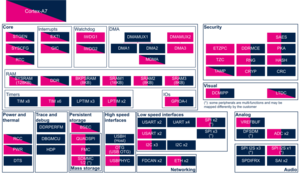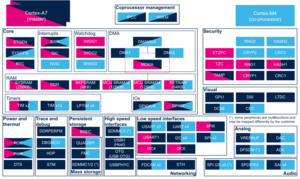1. Article purpose[edit | edit source]
The purpose of this article is to:
- briefly introduce the STGEN peripheral and its main features,
- indicate the peripheral instances assignment at boot time and their assignment at runtime (including whether instances can be allocated to secure contexts),
- list the software frameworks and drivers managing the peripheral,
- explain how to configure the peripheral.
2. Peripheral overview[edit | edit source]
The STGEN peripheral provides the reference clock used by the Arm® Cortex®-A7 generic timer for its counters, including the system tick generation.
It is clocked by either HSI(High Speed Internal oscillator) or HSE(High Speed External oscillator). During boot phase, STGEN is clocked by HSI until HSE is setup. This should be done at an early stage. Caution is needed when switching from one source to another as the STGEN counter must be updated according to the new frequency. Otherwise, the time reference will be incorrect.
The STGEN is a single-instance peripheral that can be accessed via the two following register sets:
- STGENC for the control: secure port,
- STGENR for the read-only access: non secure port.
Refer to the STM32 MPU reference manuals for the complete list of features, and to the software frameworks and drivers, introduced below, to see which features are implemented.
3. Peripheral usage[edit | edit source]
This chapter is applicable in the scope of the OpenSTLinux BSP running on the Arm® Cortex®-A processor(s), and the STM32CubeMPU Package running on the Arm® Cortex®-M processor.
3.1. Boot time assignment[edit | edit source]
3.1.1. On STM32MP1 series[edit | edit source]
The STGEN is first initialized by the ROM code, then updated by the FSBL (see Boot chain overview) once the HSE clock is set up.
Click on the right to expand the legend...
| Domain | Peripheral | Boot time allocation | Comment | |||
|---|---|---|---|---|---|---|
| Instance | Cortex-A7 secure (ROM code) |
Cortex-A7 secure (TF-A BL2) |
Cortex-A7 non-secure (U-Boot) | |||
| Core | STGEN | STGEN | ✓ | ✓ | ||
3.2. Runtime assignment[edit | edit source]
3.2.1. On STM32MP13x lines  [edit | edit source]
[edit | edit source]
Click on the right to expand the legend...
| Domain | Peripheral | Runtime allocation | Comment | ||
|---|---|---|---|---|---|
| Instance | Cortex-A7 secure (OP-TEE) |
Cortex-A7 non-secure (Linux) | |||
| Core | STGEN | STGEN | ✓ | ||
3.2.2. On STM32MP15x lines  [edit | edit source]
[edit | edit source]
Click on the right to expand the legend...
| Domain | Peripheral | Runtime allocation | Comment | |||
|---|---|---|---|---|---|---|
| Instance | Cortex-A7 secure (OP-TEE) |
Cortex-A7 non-secure (Linux) |
Cortex-M4 (STM32Cube) | |||
| Core | STGEN | STGEN | ✓ | |||
4. Software frameworks and drivers[edit | edit source]
Below are listed the software frameworks and drivers managing the STGEN peripheral for the embedded software components listed in the above tables.
Linux®/ U-Boot use the Arm Cortex-A7 generic timer that gets its counter from the STGEN, but this is transparent at runtime: therefore, there is no framework or driver to notice for these components.
In OP-TEE, the STGEN's counter value is saved/restored during low-power sequences to keep the platform time coherency. The STGEN configuration is done by TF-A. The frequency of the counter is restored in TF-A as well.
- TF-A BL2: STGEN configuration and frequency restoration
- OP-TEE: Context saving
5. How to assign and configure the peripheral[edit | edit source]
The peripheral assignment can be done via the STM32CubeMX graphical tool (and manually completed if needed).
This tool also helps to configure the peripheral:
- partial device trees (pin control and clock tree) generation for the OpenSTLinux software components,
- HAL initialization code generation for the STM32CubeMPU Package.
The configuration is applied by the firmware running in the context in which the peripheral is assigned.
6. References[edit | edit source]

